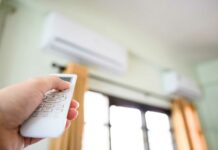Extreme home makeovers can update your living space, but an energy efficiency makeover will ensure your home performs at its peak. Everything from “low-hanging fruit,” like swapping out lightbulbs, to “bigger ticket” items such as replacing appliances with newer, energy-saving models is fair game.
Finding ‘Energy Hogs’
If you’re ready to take on a home efficiency makeover, the first step is to call your local electric co-op about an energy audit.
Your electric co-op or a qualified, licensed contractor can conduct blower-door tests or even imaging tests with an infrared camera. Blower-door tests find out how much air your home loses every hour, while infrared cameras can more accurately pinpoint where your home loses air. Common culprits include windows, doors and roofs, but air loss can occur in small and innocuous places, such as recessed canister lights and outlets, too.
Next, evaluate your appliances, HVAC (heating, ventilation and cooling) system, and even landscaping for more opportunities.
Lighting
An ENERGY STAR®-qualified compact fluorescent lightbulb uses about 75 percent less energy than a traditional incandescent bulb, lasts up to 10 times longer, and can save about $40 in energy costs over its lifetime. Light-emitting diodes (LEDs) can last even longer, but costs are still high although they keep dropping as the technology becomes less expensive to produce.
A word of warning when purchasing new types of bulbs: You generally get what you pay for.
“Some manufacturers exaggerate claims of energy savings and lifespans, and cheaper models probably won’t last as long as higher-quality bulbs,” says Brian Sloboda, senior program manager for the Cooperative Research Network, an arm of the Arlington, Va.-based National Rural Electric Cooperative Association. “If you look for the ENERGY STAR label, that means the bulb exceeds minimum efficiency standards as tested by the federal government.”
He adds: “The best way to benefit is to purchase a more energy-efficient lightbulb the next time you need one.”
Visit energysavers.gov/lighting to learn about other lighting options.
Seal Air Leaks
A tube of caulk and a roll of weather stripping can go a long way toward saving money on your electricity bill. Caulk around windows, dryer vents, and fans, and weather strip around doors.
There are also some not-so-obvious places for air to flow in and out of your home, notably outlets and behind switch plates. To see if you have air flowing through your outlets or switch plates, light a stick of incense, hold it in front, and watch for the smoke to be disrupted. You can find special sealing kits for outlets and switch plates at home improvement stores.
And don’t forget about applying weather stripping around your attic hatch or pull-down stairs. You may also want to install an insulator box to place over the opening. A kit costs around $40.
Sealing up cracks and joists in your attic will help your insulation do its job. But if an infrared scan reveals heat loss through the roof, additional or a different type of attic insulation might be necessary. Use the U.S. Department of Energy (DOE) calculator to see how much is recommended for your climate: tinyurl.com/nbtmt5y.
Programmable Thermostats
A programmable model could help you save big bucks if it fits your lifestyle. This device will turn your temperature up automatically during times of the day you specify. But if you purchase one, it’s important to take the next step and program it—a step many people fail to take.
“A programmable thermostat is an excellent tool to improve your home’s energy efficiency, but you have to actually program it, and then you have to leave it alone,” Sloboda explains. “Fiddling with the settings won’t help—but getting the settings to where you’re comfortable when you’re home and then forgetting about it will really help with energy savings.”
Programmable thermostats are best for people who regularly leave their homes (without pets inside) for at least eight hours at a time.
Sealing Ductwork
Ductwork could be the most important piece of equipment to seal. If it’s exposed, you can do this yourself with a paintbrush and mastic, which you can purchase at any home improvement store. If not, hire a professional HVAC contractor.
Leaky ductwork will make your HVAC system work a lot harder than it should have to, which drives up your electric bills and wears out HVAC equipment more quickly.
“Ductwork is one of the first places you should look if you’re trying to lower your energy costs,” stresses Art Thayer, energy efficiency programs director for the Michigan Electric Cooperative Association. “Sometimes, ducts aren’t even properly joined at all. That wastes a huge amount of energy. Sealing them up goes a long way to improving your home’s energy efficiency.”
Landscaping
Planting a tree or climbing vine not only adds flavor to your home’s landscape; it can also cool down your house when the sun beats down. Trees in the right spot can decrease your home’s energy use by up to 25 percent, according to DOE.
Plant deciduous trees—those that lose their leaves every year—to the south and west of your home, and you’ll gain shade in the summer and sunshine in the winter. According to DOE, a 6-foot, 8-inch deciduous tree will begin providing shade the first year. And it only gets cooler after that, reaching your roof line in five to 10 years.
If you want shade all the time or need to block wind, choose evergreens. But when you’re preparing to choose your greenery, keep in mind that trees should never be planted underneath a power line. Call your electric co-op to find out how far from lines you should plant, and visit ArborDay.org to learn about the types of trees that are best for your home’s landscape.
Appliances
Appliances more than 10 years old don’t work as efficiently as newer ENERGY STAR-rated models. ENERGY STAR-qualified refrigerators are 15 percent more efficient than non-qualified models and are 20 percent more efficient than models that simply meet the federal minimum standard for energy efficiency.
Clothes washers manufactured before 1998 are significantly less efficient than newer models; ENERGY STAR-certified washers use about 20 percent less energy and 35 percent less water than regular washers.
ENERGYSTAR.gov lists dozens of appliances and electronics that exceed efficiency standards; check there for more information.
Magen Howard writes on consumer and cooperative affairs for the National Rural Electric Cooperative Association, the Arlington, Va.-based service arm of the nation’s 900-plus consumer-owned, not-for-profit electric co-ops.





